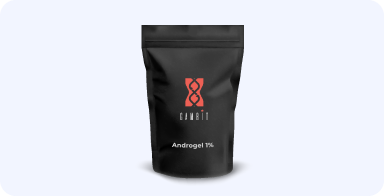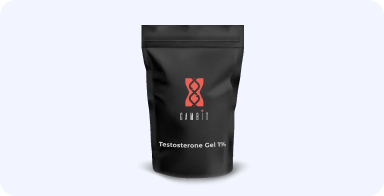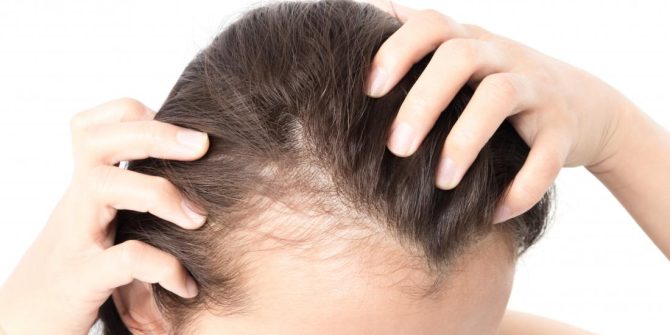Our hair is not only a major part of our physical appearance but also intrinsic to our identity. Society associates hair with prosperity and vitality; for men, hair is seen...
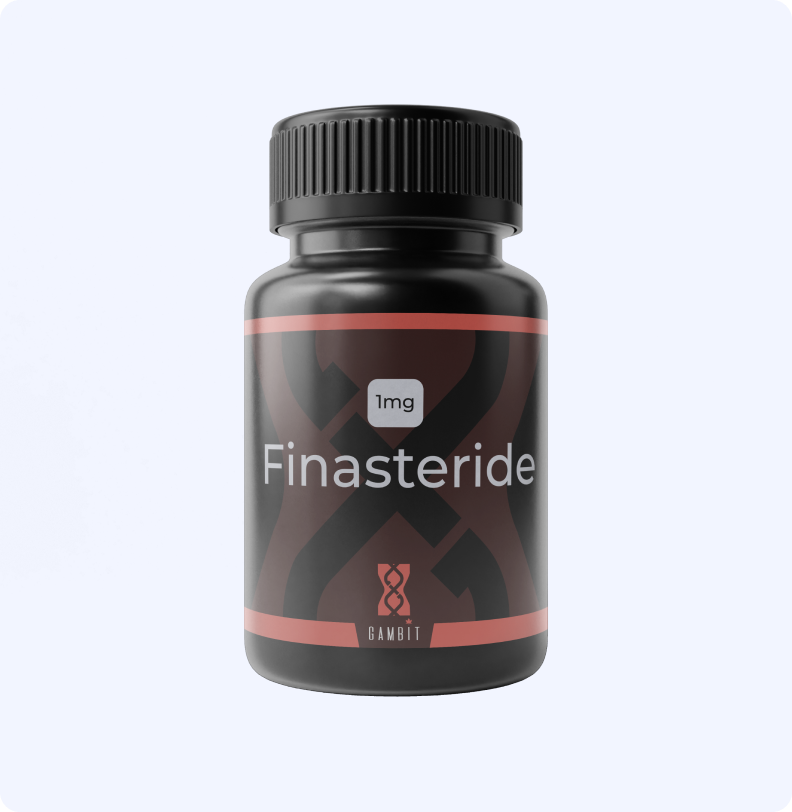
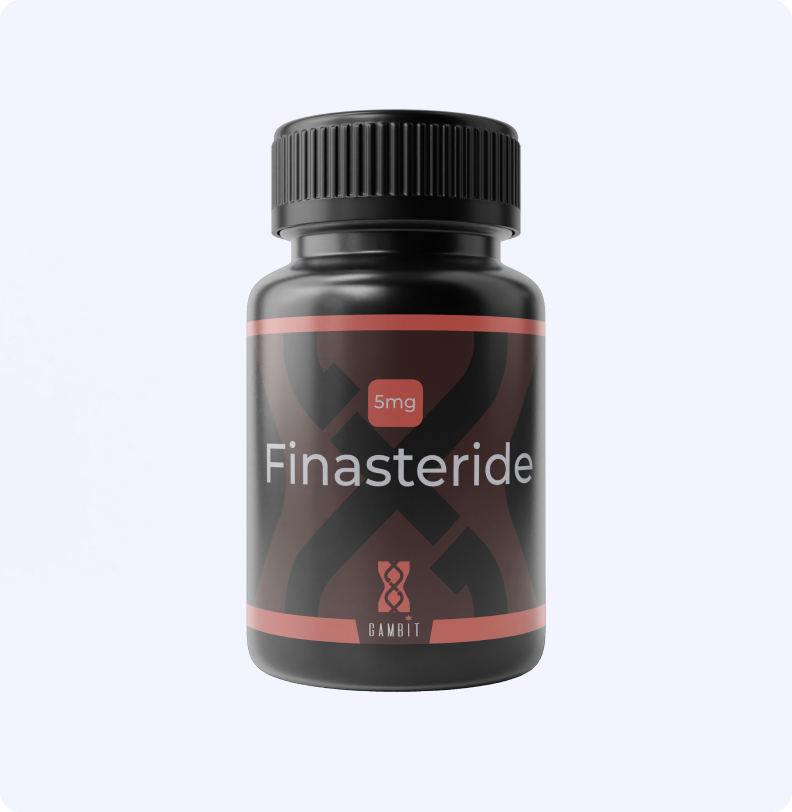
The product images shown are for illustration purposes only and may not be an exact representation of the product.
Finasteride (Generic Propecia®)
Finasteride is a prescription medication for hair loss that targets the hormone dihydrotestosterone (DHT), a key factor in androgenetic alopecia. By inhibiting the enzyme 5-alpha reductase, it reduces DHT levels, helping to slow hair loss and promote regrowth, particularly in the crown and mid-scalp. At Get Gambit, Finasteride is part of a personalized approach to your hair loss treatment plan.
The effects of Finasteride take time to become noticeable, as hair growth cycles are gradual. Most individuals begin to see a reduction in hair loss within six months of consistent use. Visible improvements in hair density and regrowth typically appear after six to twelve months. Patience is key, as stopping treatment can reverse any progress made. Our health team will monitor your progress and ensure that your hair loss treatment plan stays on track.
Finasteride and Minoxidil work differently to address hair loss and can often complement one another for enhanced results. Finasteride reduces DHT levels, addressing the hormonal cause of hair loss and preventing further thinning. It is particularly effective for slowing hair loss in the crown and mid-scalp regions.
Minoxidil, on the other hand, works locally by improving blood flow to the scalp and stimulating hair follicles to promote regrowth. It’s effective for both men and women and is often used in areas like the hairline or temples.
Choosing between the two depends on your individual needs, but combining them can provide a comprehensive approach to managing hair loss. Get Gambit’s medical team can help you determine the best strategy to achieve your hair loss treatment goals.
Finasteride is a prescription medication for hair loss that targets the hormone dihydrotestosterone (DHT), a key factor in androgenetic alopecia. By inhibiting the enzyme 5-alpha reductase, it reduces DHT levels, helping to slow hair loss and promote regrowth, particularly in the crown and mid-scalp. At Get Gambit, Finasteride is part of a personalized approach to your hair loss treatment plan.
The effects of Finasteride take time to become noticeable, as hair growth cycles are gradual. Most individuals begin to see a reduction in hair loss within six months of consistent use. Visible improvements in hair density and regrowth typically appear after six to twelve months. Patience is key, as stopping treatment can reverse any progress made. Our health team will monitor your progress and ensure that your hair loss treatment plan stays on track.
Finasteride and Minoxidil work differently to address hair loss and can often complement one another for enhanced results. Finasteride reduces DHT levels, addressing the hormonal cause of hair loss and preventing further thinning. It is particularly effective for slowing hair loss in the crown and mid-scalp regions.
Minoxidil, on the other hand, works locally by improving blood flow to the scalp and stimulating hair follicles to promote regrowth. It’s effective for both men and women and is often used in areas like the hairline or temples.
Choosing between the two depends on your individual needs, but combining them can provide a comprehensive approach to managing hair loss. Get Gambit’s medical team can help you determine the best strategy to achieve your hair loss treatment goals.
Why Finasteride (Generic Propecia®)?
Supports Hair Regrowth and Scalp Health
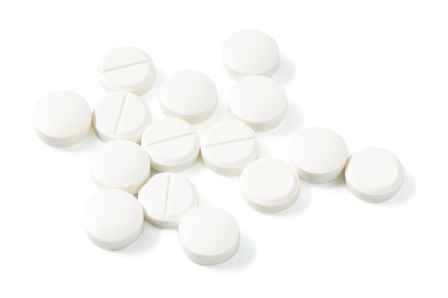
Clinically Proven Solution for Hair Loss
Finasteride is a trusted and clinically approved treatment for male pattern baldness. With consistent use, it helps slow down hair loss, increase hair density, and improve overall hair coverage, delivering visible and long-term result
How does it work?
How do I know how much Finasteride (Generic Propecia®) to use?
Finasteride vs. Minoxidil?
Choosing between Finasteride and Minoxidil depends on your hair loss treatment goals. Both are effective, but they differ in mechanism, cost, and application. Explore the table below to make an informed decision.
| Finasteride | Minoxidil | |
| Effectiveness | ||
| Availability | ||
| Onset Time | ||
| Flexibility in Dosing | ||
| Health Canada Approved |
Find the Right Hair Loss Solution
 Finasteride 1mg Finasteride 1mg |
 Finasteride 5mg Finasteride 5mg |
|
| Treatment for early stages of hair loss | ||
| Treatment for advanced stages of hair loss | ||
| Daily usage | ||
| Results visible in 3-6 months | ||
| Recommended for men | ||
| Can be combined with Minoxidil | ||
| Recommended course duration | Long-term |
Short-term |
| Dosage | 1 tablet per day |
1 tablet per day |
Finasteride (Generic Propecia®)
For Patients
Access a variety of resources and tools designed for your healthcare needs.
Finasteride 1mg is a prescription medication used to treat androgenetic alopecia, commonly known as male-pattern hair loss. It works by inhibiting the enzyme 5-alpha reductase, which converts testosterone into dihydrotestosterone (DHT). Elevated levels of DHT shrink hair follicles, leading to hair thinning and loss. By reducing DHT levels, Finasteride slows hair loss and can stimulate regrowth, particularly in the crown and mid-scalp areas.
Finasteride 1mg is taken orally, typically as a once-daily tablet. It’s important to take the medication at the same time each day to maintain consistent DHT suppression. You can take it with or without food, as directed by your healthcare provider. Consistent use is critical for optimal results, and missing doses may reduce the effectiveness of the treatment.
Finasteride 1mg is most effective for men experiencing early to moderate stages of androgenetic alopecia. It is particularly beneficial for those noticing thinning or hair loss in the crown or mid-scalp regions. While it is not approved for use in women, it may be prescribed off-label in certain cases. Your care team can help determine if Finasteride is the right treatment for your specific needs.
Results with Finasteride take time and patience. Most individuals begin to notice a reduction in hair shedding after three to six months of daily use. Visible regrowth or improved hair density often becomes apparent within six to twelve months. Continued use is necessary to maintain results, as stopping treatment can reverse progress.
Finasteride 1mg is generally well-tolerated, but some individuals may experience side effects. These can include decreased libido, erectile dysfunction, or breast tenderness, although such effects are rare and reversible upon discontinuation of the medication. In extremely rare cases, persistent side effects have been reported. If you experience any concerns, consult your care team for guidance on managing or adjusting your treatment.
Yes, Finasteride 1mg is often combined with other treatments, such as Topical Minoxidil, for a more comprehensive approach to hair loss management. While Finasteride addresses the hormonal cause of hair loss by reducing DHT, Minoxidil promotes blood flow to hair follicles, stimulating regrowth. Combination therapy can enhance overall results. Gambit’s Health Team can help tailor a treatment plan that incorporates multiple therapies to meet your goals.
Finasteride 1mg is effective for most men experiencing androgenetic alopecia, particularly in the crown and mid-scalp areas. However, its efficacy may vary depending on factors such as the extent of hair loss and individual response to the medication. Early intervention often yields the best outcomes. If you’re unsure if Finasteride is right for you, consult your care team for a personalized assessment and recommendation.
Finasteride 5mg is a prescription medication primarily used to treat benign prostatic hyperplasia (BPH) but is sometimes prescribed off-label for hair loss. It works by inhibiting the enzyme 5-alpha reductase, which converts testosterone into dihydrotestosterone (DHT). Since high DHT levels contribute to both hair follicle shrinkage and prostate enlargement, Finasteride 5mg significantly lowers DHT levels, reducing hair loss and potentially promoting regrowth in men with androgenetic alopecia.
Finasteride 5mg is taken orally, usually as a once-daily tablet. Since this is a higher dose than typically used for hair loss (1mg), your healthcare provider may recommend taking the full dose or splitting the tablet based on your individual needs. It can be taken with or without food, but consistency is key to maintaining DHT suppression and achieving optimal results.
Finasteride 5mg is primarily prescribed for men with BPH but may be considered for individuals experiencing significant hair loss who require stronger DHT reduction. This higher dose is not typically the first-line treatment for hair loss but may be an option for those who have not responded well to lower doses or other hair loss treatments. It is not approved for use in women and should not be handled by pregnant or breastfeeding women due to the risk of hormonal effects.
As with the lower 1mg dose, noticeable improvements in hair loss typically begin within three to six months of consistent use. Visible regrowth and increased hair density often take six to twelve months. Since hair growth cycles are slow, patience and continuous treatment are essential for maintaining results.
Finasteride 5mg carries a higher risk of side effects compared to the 1mg dose due to the need to split the tablet into 1/4 sizes to achieve a similar dose, leading to potential inaccuracies in dosing. Potential side effects include decreased libido, erectile dysfunction, reduced ejaculatory volume, and breast tenderness or enlargement. Some individuals may also experience fatigue or mood changes. While these side effects are uncommon, they may be more pronounced with the 5mg dose. If you experience persistent or concerning side effects, consult your healthcare provider for adjustments.
Yes, Finasteride 5mg can be used alongside other hair loss treatments, such as Minoxidil (oral or topical), PRP therapy, or laser therapy. Combination therapy may enhance results by addressing multiple factors contributing to hair loss. However, given the higher dose of Finasteride, your care team will assess whether additional treatments are necessary or if a lower dose may be more appropriate.
Finasteride 5mg is effective for many men experiencing androgenetic alopecia, but results vary based on genetics, the extent of hair loss, and individual response to treatment. While it can significantly reduce DHT levels and slow hair loss, it is most effective when started early before significant follicle miniaturization occurs. Your healthcare provider can determine whether Finasteride 5mg is the right choice for your specific situation.
What our customers say about us
Trustindex verifies that the original source of the review is Google. You can be smart and choose the professional medical specialist support that Get Gambit Testosterone program offers or cheap out and go somewhere else being wrongfully treated with the possible result of a and/or getting sterilized or ruining your endocrine system because of a lack of knowledge of other doctors or nurse practitioners who are not specialist and dont have the medical knowledge or no how to properly treat your Testosterone issues and they dont have good follow-up program! What do you think you should choose...? Put yourself first! I Choose Gambit!! Go get Gambit, no one else!Trustindex verifies that the original source of the review is Google. Excellent service, very helpful and take great care of their customers. Gambit always calls when they say they are going to, questions are always answered promptly and great value for services received.Trustindex verifies that the original source of the review is Google. Professional, knowledgeable, transparent and absolutely zero sales pressure. Nothing but good vibes and blue sky’s! The answer to that thing you’re missing in your life as a man lives here. Highly recommend Get Gambit.Trustindex verifies that the original source of the review is Google. I would share my experience with Get Gambit clinic . I really like the service .From all the staff. I had a great experience with them .They were very helpfull and professional .They were nice to me and they care about the patient because the patient is their priority not just think of money . I highly recommend this clinic if you need an TRT therapy .Thanks a lotTrustindex verifies that the original source of the review is Google. My trt experience with gambit has been very good. They always make sure I have enough prescriptions and answer any questions I may have. Can email them always respond in a timely fashion. And when we have problems with symptoms they always address it in a timely fashion. I can’t complain about anything since I started my trt regiment. Life is good now that I don’t have low testosterone.Trustindex verifies that the original source of the review is Google. I would like to thank everyone at the GetGambit team. And a special thank you to Eric, for helping and assisting me in looking into the best approach to getting my life back on track. I have chronic back pain and being active is very difficult. But after assessment and great talks with Eric we came up with a plan to get started. I've been on this program for just under one month and it changed my life as far as giving me me the energy and motivation to get more physically active. I started my program weighing 226lbs and now I have dropped 27lbs. I know it wasn't only the help from the GetGambit team that made this transformation. My diet changed, and the physical part of my life increased, but I can't say I could have done it alone. I am so happy to have found this team of professionals. Thank you again everyone at GetGambit.Trustindex verifies that the original source of the review is Google. An excellent and professional approach in everything .from custumer service,diagnostic, pharmacy,,doctors and delivery of medication,I would give them a 10 star if I can,thanks Get Gambit and special thanks to Issmael the ceo,CongratulationsTrustindex verifies that the original source of the review is Google. bullshit total bullshit almost $3000 for 30 days for one bottle of steroids that cost $77 at Rexxall-I’ll see him in courtTrustindex verifies that the original source of the review is Google. Probably one of the best companies for customer service. Very thorough. These guys went out of there way to reduce cost for being on disability very appreciated thank you. Unfortunately I ended up having to go through doctor. No offense to these guys but as you know disability pays jack shit. However if you are seeking to try testosterone replacement therapy these guys are definitely a great choice. So easy quick. There's a reason they have all 5 star reviews. I'm happy to add one more. Thanks guys.Trustindex verifies that the original source of the review is Google. Legit company. Lost 5 inches on waist.
Important Safety Information
Important Safety Information
Finasteride (Generic Propecia®) is an oral medication designed to treat male pattern baldness by reducing DHT levels, which helps prevent hair loss and promote regrowth. It is not recommended for use by women, children under 18, or individuals with certain medical conditions. Speak with your healthcare provider to determine if Finasteride is the right treatment for you and to discuss potential side effects or interactions.
Gambit Health Hub
Hair loss is a common problem that affects millions of people around the globe. From alopecia to male pattern baldness and chemotherapy, hair loss comes in many forms—it’s a confusing...
Other products
